
Gdynia is a city in northern Poland and a seaport on the Baltic Sea coast. With an estimated population of 257 000, it is the 12th-largest city in Poland and the second-largest in the Pomeranian Voivodeship after Gdańsk. Gdynia is part of a conurbation with the spa town of Sopot, the city of Gdańsk, and suburban communities, which together form a metropolitan area called the Tricity (Trójmiasto) with around one million inhabitants.

Kazimierz Porębski was a Polish career naval officer who rose to the position of admiral within the Imperial Russian Navy and was subsequently the first commander-in-chief of the inter-war Polish Navy.

ORP Warszawa was a large guided missile destroyer of the Polish Navy, one of the last ships of the modified Kashin class.
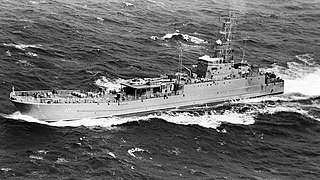
The Polnocny -class ships are amphibious warfare vessels. They were designed in Poland, in cooperation with the Soviet Navy and were built in Poland between 1967 and 2002. They now serve in several different navies, and some have been converted to civilian use. The name comes from the Stocznia Północna shipyard at Gdańsk, where they were built. 107 were built by 1986. In 2002, one ship of a modernised design NS-722 was built in Gdynia for Yemen.

Jerzy Włodzimierz Świrski was a Polish vice admiral and officer in the Russian Imperial Navy and later the Polish Navy. As Chief of the Polish Naval Command (1925-1947), he was a member of an elite group of high ranking Polish naval officers from foreign navies who became founder members of the re-established naval forces of the newly independent Poland after World War I. During World War II, Polish naval forces under his command, were embedded with the Royal Navy and contributed significantly to the success of Britain's maritime war effort. He notably fell out with Poland's war time Prime Minister-in-exile, General Sikorski, but was backed by the British and survived in post. He was appointed an Honorary Knight Commander of the Order of the Bath.
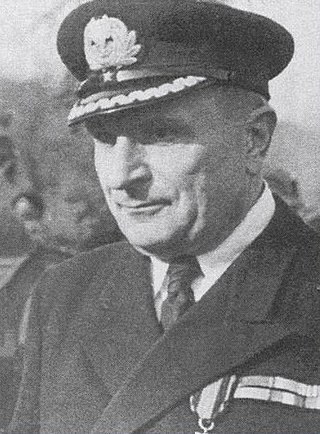
Adam Mohuczy (1891–1953) was a Polish Navy officer. Captain of several ships and squadrons, Counter Admiral from 1946 and Chief of Staff and Commander of the Polish Navy from 1945 to 1947. In 1949 arrested by Polish secret police, accused of sabotage, tortured. He died in prison in 1953. In 1957 he was rehabilitated.
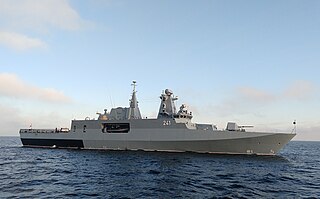
The Gawron class or Projekt 621 was a planned class of multipurpose corvettes ordered by Polish Navy. The Gawron class was a variant of the MEKO A-100 project developed by the Blohm + Voss shipyard in Germany. Construction of the first ship of the class started in 2001. The project was terminated in February 2012 but in October 2013 a contract was signed to complete the existing hull as a patrol ship by 2016. On 2 July 2015, ORP Ślązak was christened and launched, and on 28 November 2019, ORP Ślązak was officially commissioned into the Polish Navy.
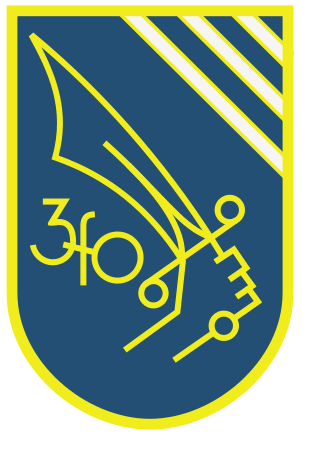
3rd Ship Flotilla is a tactical unit of the Polish Navy composed of 11 subunits. The unit is a main strike force of the Polish Navy, it operates various warships types such as frigates, corvettes, submarines or fast attack crafts. The main base of 3 FO is Gdynia-Oksywie Naval Base.
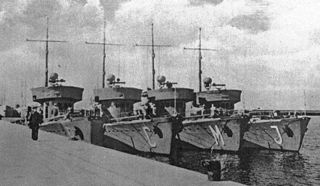
ORP Żuraw was a Jaskółka-class minesweeper of the Polish Navy at the outset of World War II. Her name is the Polish word for the common crane. Żuraw participated in the defense of Poland during the German invasion of 1939. The ship was surrendered to the Germans following the Polish capitulation and renamed Oxhöft as a naval trawler. Following the German surrender at the end of the war, the ship was returned to Poland under her old name. In 1947, Żuraw was modified for use as a hydrographical survey ship and renamed Kompas. She was broken up in 1981.

The Polish Navy is the naval branch of the Polish Armed Forces. The Polish Navy consists of 46 ships and about 12,000 commissioned and enlisted personnel. The traditional ship prefix in the Polish Navy is ORP.
The improved Grom-class destroyers of 1939 were the third and fourth planned ships of the Grom class of destroyers ordered for the Polish Navy shortly before World War II. They were to be built in Poland, the first destroyers so constructed, and were to be named Huragan ("hurricane") and Orkan ("windstorm"), respectively. Their design included greater power and displacement than the first two ships of the class. Their construction was interrupted by the beginning of World War II and they were never completed.

The Polish Naval Academy (PNA) "Heroes of Westerplatte" is a naval university supervised by the Ministry of National Defence of the Republic of Poland, with the history, uninterrupted by World War II, dating back to 1922. At present the PNA provides education for officer-cadets, commissioned officers and civilian students at first and second cycles of study, as well as doctoral studies. It also offers opportunities for professional development at specialized courses and postgraduate programs. In accordance with international agreements the PNA trains officers for naval forces of countries in Europe, North Africa, the Middle and Far East. International exchange significantly contributes to the rise in qualifications of the PNA staff. It also allows the students to attend lectures given by best specialists from leading scientific centers of the world.

ORP Ślązak (241) is an offshore patrol vessel of the Polish Navy, formerly known as Gawron-class corvette. The ship is named Ślązak. It is a licence variant of the MEKO A-100 project developed by Blohm + Voss.

Bolesław Romanowski was a submarine commander of the Polish Navy during World War II.
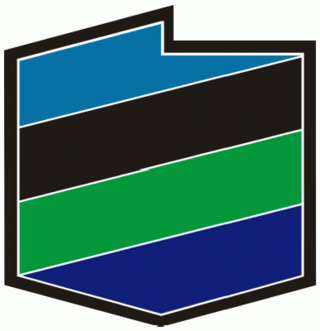
The Armed Forces General Command is a joint command of the Polish Armed Forces, responsible for the combat training and readiness, supply, personnel and technical complement of military units of the armed forces during peace and crisis. It holds administrative command of the units, which are transferred under the operational control of the Armed Forces Operational Command. The current General Commander is Lt Gen Wiesław Kukuła (pl). It is subordinated to the Chief of the General Staff.

ORP Mewa is a Polish base minesweeper from the Cold War era, one of a series of 12 vessels of Projekt 206F, converted between 1998 and 1999 to a minehunter of Projekt 206FM. The unit measured 58.2 meters in length, 7.97 meters in width, and had a draft of 2.14 meters, with a full displacement of 470 tons. It was armed with three double sets of 25 mm 2M-3M autocannons and depth charges, and was also adapted for transporting and deploying naval mines.

ORP Flaming was a Polish base minesweeper from the Cold War era, one of 12 ships of Projekt 206F, rebuilt between 2000 and 2001 into a minehunter. The vessel measured 58.2 meters in length, 7.97 meters in width, and had a draft of 2.14 meters, with a full displacement of 470 tons. It was armed with three twin-mounted 25 mm 2M-3M automatic guns and depth charges, and was also equipped to carry and deploy naval mines.

ORP Czajka is a Polish base minesweeper from the Cold War era, one of a series of 12 vessels of Projekt 206F, converted between 1998 and 1999 to a minehunter of Projekt 206FM. The unit measured 58.2 meters in length, 7.97 meters in width, and had a draft of 2.14 meters, with a full displacement of 470 tons. It was armed with three double sets of 25 mm 2M-3M autocannons and depth charges, and was also adapted for transporting and deploying naval mines.
















